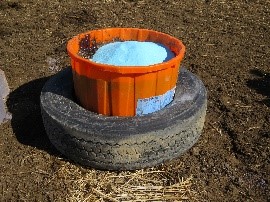Last updated on October 10th, 2023 at 01:38 pm
What Is Grass Tetany?
Grass tetany is known by many different names including, but not limited to, grass staggers, hypomagnesemia, hypomagnesemic tetany, lactation tetany, winter tetany, wheat pasture poisoning, barley poisoning, and others! Often occurring after turning cattle out to pasture, this metabolic disorder is more common in older, thin (or even overly fat), lactating cows, and is possibly more prevalent in cattle that are Angus or Angus influence.

What Causes Grass Tetany in Cattle & Can You Prevent It?
Cause
In many regions, the warmer weather of spring brings rapidly growing, lush, green grass. While on the one hand, this is a welcomed sight it is often a concern for many because the risk of grass tetany is higher with early lactating cows turned out to graze fast-growing grasses. The grass can become high in potassium and nitrogen, and cows become low in magnesium.
Preventive Measures
Providing magnesium supplements like Riomax360™ will help to reduce the risk of this deadly metabolic imbalance. Riomax® should be available consistently - prior to turnout, as well as during the lush grazing season for the maximum benefit.
An often-overlooked factor is the palatability of your magnesium supplement. When grass is lush, green, and tasty it can sometimes be difficult to draw cattle to mineral supplements so make sure the product you chose is highly palatable but not to the point where the cows devour the product at an unsustainable rate. Riomax® is made with a pure, high-grade, cooked molasses base, without any bittering agents and this has the ability to attract cattle back to frequent the feeding station on a regular basis.
In addition to feeding supplemental magnesium, producers must keep out free-choice salt, with multiple feeding stations, in easily accessible locations. Feeding salt is often overlooked, but it is extremely important. The sodium from the salt is critical in allowing the cow to absorb magnesium. Studies have shown low levels of sodium can potentially reduce magnesium absorption to the point of causing an onset of quickly progressing grass tetany, which is very likely to be fatal. Loose salt is the best option as this will allow the cow to consume a large amount, when she needs it, with minimal effort. If loose salt is not available, block salt can be used but will not be as easy to intake and thus will reduce the effectiveness when rapid salt consumption is needed. To give the cow the best chance of nutritional success, feed Riomax along with free choice loose salt.



Can you treat grass tetany in cattle?
This is a good question but unfortunately, often the first sign of grass tetany is dead cows. On the occasion of the discovery of a mild case, you will notice the animal appear to be hyper-alert or nervous and at this point, administering magnesium sulfate subcutaneously is sometimes effective. The animal may act dazed or be staring, have sections of their skin twitching, and even stagger and be easily startled. Often quickly progressing, the animal will develop a pounding heartbeat, usually go into convulsions, and die.
If treatment is going to be effective, gentle, quiet handling is critical to avoid startling and over-excitement which can cause sudden death.
Want to learn more? Let's get in touch so you can reduce or prevent grass tetany cases on your operation.


